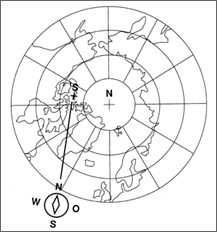Earth's magnetism - our planet as a giant magnet
Earth's magnetic field and its crucial role

Earth's magnetic field and its crucial role
Earth has a fascinating magnetic field that plays a vital role in protecting our planet. It consists of north and south poles, with the geographic north pole aligning with the magnetic north pole, and the geographic south pole aligning with the magnetic south pole. Eddy currents within Earth's interior cause the magnetic poles to constantly shift.
The magnetic south pole is currently located in northern Canada, approximately 1,000 km from the geographic north pole. A compass needle points with a deviation, known as magnetic declination, which in Poland is currently 2.5°. Studies have shown that the magnetic south pole shifted over 190 km within five years from 1995 to 2000.
Analyses of volcanic rocks have revealed that Earth's magnetic field has reversed its polarity multiple times. The field's strength varies depending on the location, being strongest at the poles. It can be weakened by the presence of metals such as nickel, iron, and cobalt in Earth's crust. Despite its scale, Earth's magnetic field is significantly weaker than that of permanent magnets, like neodymium (NdFeB) or samarium-cobalt (SmCo) magnets.
The process of generating the field, known as geodynamo, relies on the movement of liquid iron in Earth's outer core. These movements generate electric currents, which in turn create the magnetic field. For this process to occur, the planet must have rapid rotation, a liquid interior capable of conducting electricity, and an energy source driving convection currents.
Understanding Earth's magnetic field is crucial for science and technology, from navigation to protecting infrastructure against geomagnetic storms.
How does Earth's magnetic field protect our planet?
The magnetosphere, which surrounds Earth, acts as a protective shield by deflecting harmful particles from the solar wind and cosmic radiation. This protection prevents atmospheric erosion, maintaining the conditions necessary for life.
However, the magnetosphere is not invincible. Intense geomagnetic storms, triggered by solar activity, can disrupt satellites, navigation systems, and radio communications. A notable example is the geomagnetic storm of 1859, known as the Carrington event, which caused global telegraph system failures.
Phenomena associated with Earth's magnetic field
Earth's magnetic field generates many fascinating phenomena. Auroras, caused by the interaction of solar wind particles with the atmosphere, are among the most spectacular effects of the magnetosphere. The magnetic field also influences navigation and animal migration.
Geological studies show that Earth's magnetic field has reversed polarity multiple times in the past, affecting climate and geological processes. Understanding these mechanisms is essential for future predictions and the development of technologies that harness the potential of magnetism.

Earth's magnetism
Magnetic field lines of the geodynamo radiate from Earth's surface at various angles to the polar axis, creating unique patterns. These lines resemble the arrangement of force lines around permanent magnets, but their scale and influence on life are much greater. The magnetic flux contributes to spectacular phenomena like auroras, visible in polar regions.
Magnetism has fascinated humanity for millennia. Compasses, used since the 13th century, were among the first practical applications of Earth's magnetic field, enabling geographic discoveries. Today, the magnetic field inspires advanced technologies, such as magnetic levitation trains and navigation systems. Understanding Earth's magnetic field also drives the development of new materials and technologies vital for industry, communication, and daily life.

(magnetic field sensor, i.e., a compass)
The compass follows the magnetic field lines.

repels

repels

attracts

attracts

